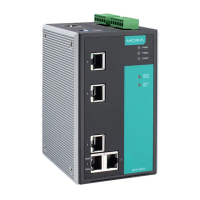Moxa Managed Ethernet Switch/Extender Featured Functions
Trunk Type
Setting Description Factory Default
Static Selects Moxa’s proprietary trunking protocol. Static
LACP Selects LACP (IEEE 802.3ad, Link Aggregation Control
Protocol).
Static
Available Ports/Member Ports
Setting Description Factory Default
Member/Available
ports
Lists the ports in the current trunk group and the ports that are
available to be added.
N/A
Check box Selects the port to be added or removed from the group. Unchecked
How each port is identified.
Port description Displays the media type for each port. N/A
Name Displays the specified name for each port. N/A
Speed Indicates the transmission speed for each port (1G-Full,
100M-Full, 100M-Half, 10M-Full, or 10M-Half).
N/A
FDX flow control Indicates if the FDX flow control of this port is enabled or
disabled.
N/A
Up Add selected ports into the trunk group from available ports. N/A
Down Remove selected ports from the trunk group. N/A
Trunk Table
Trunk group Displays the trunk type and trunk group.
Member port Displays the member ports that belong to the trunk group.
Status • Success means port trunking is working properly.
• Fail means port trunking is not working properly.
• Standby means port trunking is working as a standby port. When there are
more than eight ports trunked as a trunking group, the 9th port will be the
standby port.
Configuring SNMP
The Moxa switch supports SNMP V1, V2c, and V3. SNMP V1 and SNMP V2c use a community string match for
authentication, which means that SNMP servers access all objects with read-only or read/write permissions
using the community strings public and private by default. SNMP V3 requires that you select an authentication
level of MD5 or SHA, and is the most secure protocol. You can also enable data encryption to enhance data
security.
Supported SNMP security modes and levels are shown in the following table. Select the security mode and level
that will be used to communicate between the SNMP agent and manager.

